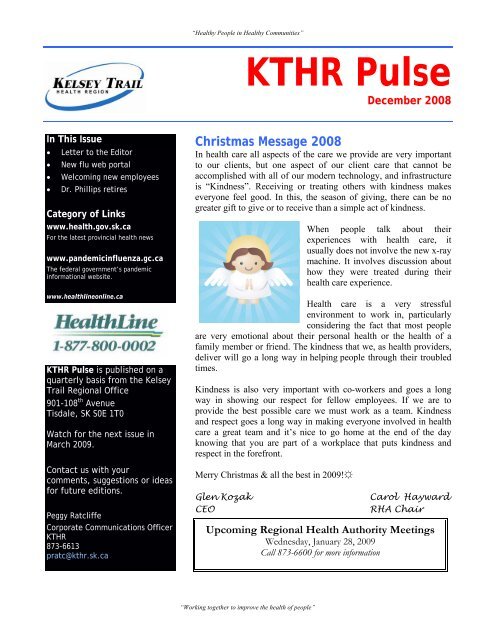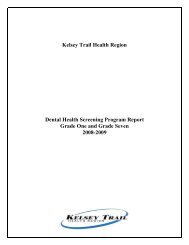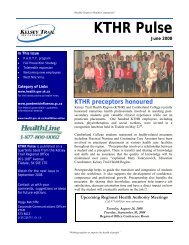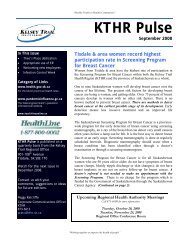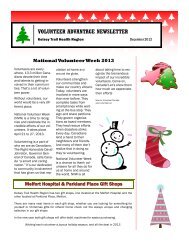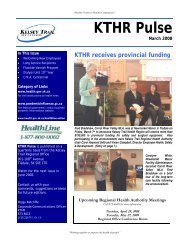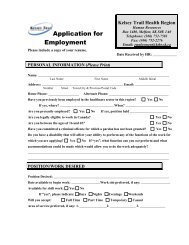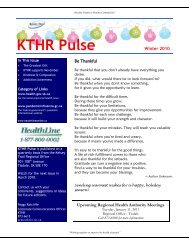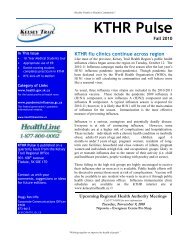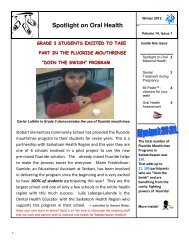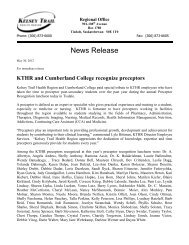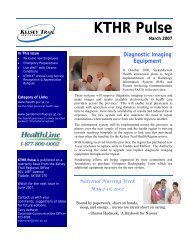KTHR Pulse December 2008.pdf - Kelsey Trail Health Region
KTHR Pulse December 2008.pdf - Kelsey Trail Health Region
KTHR Pulse December 2008.pdf - Kelsey Trail Health Region
Create successful ePaper yourself
Turn your PDF publications into a flip-book with our unique Google optimized e-Paper software.
“<strong>Health</strong>y People in <strong>Health</strong>y Communities”<br />
<strong>KTHR</strong> <strong>Pulse</strong><br />
<strong>December</strong> 2008<br />
In This Issue<br />
• Letter to the Editor<br />
• New flu web portal<br />
• Welcoming new employees<br />
• Dr. Phillips retires<br />
Category of Links<br />
www.health.gov.sk.ca<br />
For the latest provincial health news<br />
www.pandemicinfluenza.gc.ca<br />
The federal government’s pandemic<br />
informational website.<br />
www.healthlineonline.ca<br />
<strong>KTHR</strong> <strong>Pulse</strong> is published on a<br />
quarterly basis from the <strong>Kelsey</strong><br />
<strong>Trail</strong> <strong>Region</strong>al Office<br />
901-108 th Avenue<br />
Tisdale, SK S0E 1T0<br />
Watch for the next issue in<br />
March 2009.<br />
Contact us with your<br />
comments, suggestions or ideas<br />
for future editions.<br />
Peggy Ratcliffe<br />
Corporate Communications Officer<br />
<strong>KTHR</strong><br />
873-6613<br />
pratc@kthr.sk.ca<br />
Christmas Message 2008<br />
In health care all aspects of the care we provide are very important<br />
to our clients, but one aspect of our client care that cannot be<br />
accomplished with all of our modern technology, and infrastructure<br />
is “Kindness”. Receiving or treating others with kindness makes<br />
everyone feel good. In this, the season of giving, there can be no<br />
greater gift to give or to receive than a simple act of kindness.<br />
When people talk about their<br />
experiences with health care, it<br />
usually does not involve the new x-ray<br />
machine. It involves discussion about<br />
how they were treated during their<br />
health care experience.<br />
<strong>Health</strong> care is a very stressful<br />
environment to work in, particularly<br />
considering the fact that most people<br />
are very emotional about their personal health or the health of a<br />
family member or friend. The kindness that we, as health providers,<br />
deliver will go a long way in helping people through their troubled<br />
times.<br />
Kindness is also very important with co-workers and goes a long<br />
way in showing our respect for fellow employees. If we are to<br />
provide the best possible care we must work as a team. Kindness<br />
and respect goes a long way in making everyone involved in health<br />
care a great team and it’s nice to go home at the end of the day<br />
knowing that you are part of a workplace that puts kindness and<br />
respect in the forefront.<br />
Merry Christmas & all the best in 2009!☼<br />
Glen Kozak<br />
CEO<br />
Carol Hayward<br />
RHA Chair<br />
Upcoming <strong>Region</strong>al <strong>Health</strong> Authority Meetings<br />
Wednesday, January 28, 2009<br />
Call 873-6600 for more information<br />
“Working together to improve the health of people”
<strong>KTHR</strong> <strong>Pulse</strong> “<strong>Health</strong>y People in <strong>Health</strong>y Communities” Page 2 of 16<br />
The Ultimate Gift: Saving a life<br />
As we move into the season of giving, Canadian Blood Services would like to remind you that there is no<br />
more precious gift than donating blood in order to save lives.<br />
“The holiday season is the perfect time to become a blood donor,” said Donna Wunderlich, Director of<br />
Donor and Clinic Services for the Prairie region of Canadian Blood Services. “The need for blood and<br />
blood products remains high throughout the year, but it is always especially poignant during the holidays.<br />
What better way to show the true spirit of the season than by helping to save a life.”<br />
Wunderlich noted that each blood donation actually has the potential to help as many as three patients.<br />
“Canadian Blood Services is able to separate each unit into red cells, plasma and platelets and provide<br />
these products to patients in need,” she said.<br />
According to Canadian Blood Services, it is estimated that one in two Canadians is eligible to donate<br />
blood, yet only one in 60 actually does.<br />
“Quite simply, we need new donors,” said<br />
Wunderlich.<br />
For more information on blood donation, or<br />
to make an appointment to donate, please<br />
call Canadian Blood Services, toll-free at 1<br />
888 2 DONATE (1888 236 6283).<br />
Canadian Blood Services is a national, notfor-profit<br />
charitable organization that<br />
manages the blood supply in all provinces<br />
and territories (except Quebec) and oversees<br />
OneMatch -the Stem Cell and Marrow Network. A dedicated team of 4,800 staff and 17,000 volunteers<br />
enable us to operate 40 permanent collection sites and more than 20,000 donor clinics annually. While<br />
Canadian Blood Services is a non-governmental organization, it receives operational funding from the<br />
Provincial and Territorial Ministers of <strong>Health</strong> and is regulated by <strong>Health</strong> Canada. For more information,<br />
please visit www.blood.ca.☼<br />
Have you or someone you know received blood?<br />
Approximately every minute of every day, someone in Canada needs blood.<br />
Fifty-two percent of Canadians say they, or a family member, have needed<br />
blood or blood products for surgery or for medical treatment.<br />
Give a heartfelt “thanks” to donors by sharing your story and inspiring others to<br />
donate at www.ThankYourDonor.ca.☼<br />
“Working together to improve the health of people”
<strong>KTHR</strong> <strong>Pulse</strong> “<strong>Health</strong>y People in <strong>Health</strong>y Communities” Page 3 of 16<br />
TMSS students donate<br />
time to help <strong>KTHR</strong><br />
During several weeks in the month of October,<br />
Tisdale Middle & Secondary School students<br />
helped lend their time to assist <strong>Kelsey</strong> <strong>Trail</strong><br />
<strong>Health</strong> <strong>Region</strong> with the production of buttons<br />
that were distributed among staff during<br />
Infection Control Week (Ask Me If I’ve Washed<br />
My Hands); to kick off the annual flu shot<br />
campaign (I’ve Had My Flu Shot…Have You);<br />
and Focus on Patient Safety Education Day<br />
(Ethics Matter and Focus on Patient Safety).<br />
The buttons prompted interesting conversation<br />
among health care providers, patients, visitors<br />
and the public and will be re-used in the future.<br />
<strong>KTHR</strong> appreciated the helping hands.☼<br />
Letter to the Editor<br />
I would like to thank the community of Naicam and surrounding areas for the wonderful support<br />
given to me over the past 6 ½ years during my time at the Naicam Primary Care Clinic. While<br />
‘pioneering’ the clinic, we have progressed over the years and are hopeful that becoming a healthier<br />
community will continue. I have enjoyed my years here in Naicam and will always remember how<br />
welcoming you have all been to me. I do hope that the idea of Primary <strong>Health</strong> Care and Nurse<br />
Practitioners becomes more openly accepted throughout the <strong>Health</strong> region, as you as a community<br />
have shown me is possible.<br />
Again thank you for all the years of support, fun and even some tears, it has been a wonderful time<br />
in my life and career.<br />
A special Thank You to Linda Barlow, my ‘boss’. I could not have asked for anyone better, she was<br />
always very supportive and encouraging whether it was my professional life or personal. She is a<br />
great leader and has more determination than most people I know. I was very fortunate to have worked<br />
with her.<br />
And finally, Kelly Crozon, to say Thank You seems so minimal. Kelly has been so very supportive,<br />
understanding and patient over the past 6 ½ yrs with me and without her the Naicam clinic would<br />
not have been such a success. Not only is Kelly an excellent support but has become truly a very best<br />
friend, and that I will miss the most of all.<br />
So to everyone, Thank You again, and this is not good bye, but ‘til we meet again.☼<br />
Cheryl Weger<br />
“Working together to improve the health of people”
<strong>KTHR</strong> <strong>Pulse</strong> “<strong>Health</strong>y People in <strong>Health</strong>y Communities” Page 4 of 16<br />
“<strong>Health</strong> Tips” in medical clinics in <strong>KTHR</strong><br />
Saskatchewan is expanding an<br />
innovative project that provides<br />
practical health information to<br />
people while they visit doctors'<br />
offices.<br />
"<strong>Health</strong> Tips" uses wireless<br />
technology to deliver video<br />
health messages in physicians'<br />
office waiting rooms. It can be<br />
instantly updated by remote. The<br />
project began as a pilot in 20<br />
clinics, and has now expanded to<br />
100 locations across<br />
Saskatchewan. Within the<br />
<strong>Kelsey</strong> <strong>Trail</strong> <strong>Health</strong> <strong>Region</strong>,<br />
“<strong>Health</strong> Tips” are now available<br />
at the Hudson Bay Medical<br />
Group, Kelvington Medical<br />
Clinic, Nipawin <strong>Health</strong> Centre,<br />
Nipawin Medical Group and the<br />
Porcupine Plain Medical Clinic.<br />
"Our government wants to<br />
ensure that people make healthy<br />
lifestyle choices based on<br />
reliable, current information,"<br />
<strong>Health</strong> Minister Don McMorris<br />
said. "This service provides<br />
useful, timely, health advice. It<br />
also encourages patients to ask<br />
their doctors more informed<br />
questions, because it's available<br />
when they're already thinking<br />
about their health."<br />
The video is regularly updated to<br />
include seasonal or timely topics<br />
such as West Nile Virus, flu<br />
shots and drug coverage<br />
changes. It offers information on<br />
subjects including cancer<br />
services, the surgical care<br />
process, medical coverage,<br />
healthy lifestyles, and a variety<br />
of specific health conditions.<br />
The Saskatchewan Medical<br />
Association participated in<br />
development of the video<br />
content, and strongly supports<br />
and promotes the program.<br />
"The Saskatchewan Medical<br />
Association has been proud to<br />
support this initiative from the<br />
outset," SMA president Dr. Milo<br />
Fink said. "Providing patients<br />
with information in this way not<br />
only contributes to their overall<br />
health knowledge, it helps enrich<br />
patient-physician contact so that<br />
both parties are able to get the<br />
most out of an appointment."<br />
"Preventative medicine is the<br />
mainstay of family practice, and<br />
promotion of preventative<br />
medicine is very important in<br />
my practice," Regina physician<br />
Dr. Susanne Arndt, who is<br />
participating in the program,<br />
said. "Patients have expressed to<br />
me that they appreciate having<br />
the opportunity to learn about<br />
their health as they wait. The<br />
feedback from patients has been<br />
very positive."<br />
"We need to search out new and<br />
creative ideas, and make the<br />
most of opportunities to provide<br />
people with information,"<br />
McMorris said. "This project is a<br />
great example of an inventive<br />
application of digital technology<br />
by a Saskatchewan company."<br />
Saskatchewan <strong>Health</strong> is<br />
providing approximately<br />
$150,000 in funding this year to<br />
operate the program.☼<br />
New flu web portal launched<br />
Canada’s provinces and territories and the Public <strong>Health</strong> Agency of Canada have launched fightflu.ca, a pan-<br />
Canadian web portal designed to provide Canadians with one-stop access to information about influenza (the flu)<br />
and ways to limit its spread.<br />
Within the portal, Canadians will find general information about influenza and how it spreads, along with simple<br />
tips to prevent infection, such as: getting a flu shot; hand washing; covering coughs and sneezes; keeping shared<br />
surfaces clean; and staying home when sick.<br />
The portal also provides fact sheets on<br />
influenza and tips for avoiding infection in over<br />
10 languages. A link to the flu portal can be<br />
found on the <strong>Kelsey</strong> <strong>Trail</strong> <strong>Health</strong> <strong>Region</strong><br />
website at www.kelseytrailhealth.ca under<br />
“Your <strong>Health</strong>”.☼<br />
“Working together to improve the health of people”
<strong>KTHR</strong> <strong>Pulse</strong> “<strong>Health</strong>y People in <strong>Health</strong>y Communities” Page 5 of 16<br />
Did You Know?<br />
Saskatchewan Cancer Agency<br />
The Saskatchewan Cancer Agency is responsible for the provision of cancer prevention, early detection,<br />
treatment, research, education, and supportive care services and programs for the people of<br />
Saskatchewan. The Agency is mandated by The Saskatchewan Cancer Agency Act and Regulations to<br />
maintain a population-based cancer registry. This Act also mandates that cancer is a reportable disease in<br />
Saskatchewan; therefore, the Agency receives information on every case of cancer diagnosed in residents<br />
of the province.<br />
The Agency is also mandated by The <strong>Health</strong> Information Protection Act to maintain confidentiality of<br />
patient information. This legislation and Agency policy govern release of information from the registry.<br />
Statistical information is considered de-identified and may be shared, however identifiable information is<br />
subject to strict controls, including ethics approvals and patient consent where appropriate.<br />
The Saskatchewan Cancer Registry was established in 1932 and is the oldest cancer registry in Canada<br />
and one of the oldest in the world. In 1977 the Agency created a computerized registry system, and cases<br />
from 1967 to 1977 were back-coded onto the system. All cases from 1967 are available in an electronic<br />
format.<br />
The cancer registry is a patient-oriented database, which means that patient demographics are recorded<br />
once but may be associated with more than one case. The registry records approximately 8,500 new<br />
cases of cancer per year. Patient demographics include sex, date of birth, residence, and date and cause of<br />
death. This information is used to describe patterns of cancer, including age at diagnosis, geographic<br />
incidence and survival.<br />
Cancer case information includes date and method of diagnosis, tumour site and histology, behaviour,<br />
grade, stage of disease (where available), summary of treatment, treatment centres and disease status.<br />
Follow-up information includes date of follow-up, location of follow-up, disease status, and current<br />
treatment.<br />
Information in the registry is reportable to Statistics Canada for inclusion in Canadian cancer statistics.<br />
De-identified information is also reported to the North American Cancer Registry and the International<br />
Association for Research on Cancer for inclusion in these broader statistics.<br />
Registry data is used within the Agency for business purposes such as surveillance, budget forecasting,<br />
research, and monitoring of practices of care. Information may also be shared with external individuals<br />
performing cancer research projects.<br />
The registry is certified through the North American Association of Central Cancer Registries for the<br />
quality, completeness, timeliness of its data, and adherence to standards. Statistics Canada also provides<br />
Saskatchewan’s Ministry of <strong>Health</strong> and the Agency with a yearly report card based on the same type of<br />
analysis. The registry participates in the Agency’s accreditation process through Accreditation Canada.<br />
Additionally, in Saskatchewan, legislative authority to conduct cancer surveillance resides with the<br />
Agency, Department of Epidemiology. Cancer surveillance is the collection, review and analysis of data<br />
that describes incidence, prevalence, morbidity and mortality attributable to cancer. Cancer surveillance<br />
answers the basic question of where we are at in controlling and managing cancer. The registry provides<br />
“Working together to improve the health of people”
<strong>KTHR</strong> <strong>Pulse</strong> “<strong>Health</strong>y People in <strong>Health</strong>y Communities” Page 6 of 16<br />
a rich source of information allowing effective long-term monitoring of our progress in managing cancer.<br />
The Department of Epidemiology relies on registry data to produce the Saskatchewan Cancer Control<br />
Report, which describes the burden of cancer and how it is changing over time in the Saskatchewan<br />
population. The Department of Epidemiology is responsible for evaluating the effectiveness of programs,<br />
assisting with future planning, and determining the burden of disease in the population through ongoing<br />
surveillance and research into the causes of cancer and cancer outcomes.<br />
The 2008 Saskatchewan Cancer Control Report will be released this fall and will showcase cancer<br />
prevalence and standard incidence and mortality statistics. Once the report is released, copies can be<br />
obtained through the Contact Us link on the Agency’s website at www.saskcancer.ca.☼<br />
Introducing….<br />
Scooter the Squirrel<br />
The Nipawin Primary <strong>Health</strong> Care Provider team, “Move<br />
More… Increase Childhood Activity” Working Group<br />
recently unveiled their new mascot, Scooter the Squirrel.<br />
Scooter will be used by the Nipawin Primary <strong>Health</strong> Care<br />
Provider team to promote importance and awareness of<br />
physical activity in youth in the Nipawin area.<br />
Through the use of the mascot, the Nipawin Primary <strong>Health</strong><br />
Care Provider team hopes to create awareness of childhood<br />
inactivity within the community of Nipawin while<br />
empowering youth to live healthy lives through education<br />
and encouraging positive attitudes toward physical activity,<br />
healthy eating and positive self-esteem.<br />
Scooter will make special appearances at festivals,<br />
symposiums, parades, school presentations and events,<br />
promoting messages that will inspire youth to “Get Up! Get<br />
Out! and Get Active!” by getting off the couch, going<br />
outside and getting active in sports and recreation.<br />
Nipawin area groups and organizations interested in having<br />
Scooter make a special appearance at an event are asked to<br />
contact Geoff Stewart, <strong>Kelsey</strong> <strong>Trail</strong> <strong>Health</strong> <strong>Region</strong> Exercise<br />
Therapist, at 862-7266 for more information.☼<br />
“Working together to improve the health of people”
<strong>KTHR</strong> <strong>Pulse</strong> “<strong>Health</strong>y People in <strong>Health</strong>y Communities” Page 7 of 16<br />
<strong>KTHR</strong> selected to participate in<br />
national medication safety pilot project<br />
<strong>Kelsey</strong> <strong>Trail</strong> <strong>Health</strong> <strong>Region</strong> is one of nine health<br />
regions in Canada that has been chosen to<br />
participate in the Canadian Medication Incident<br />
Reporting and Prevention System (CMIRPS)<br />
pilot project focused on the development and<br />
implementation of a national medication incident<br />
reporting and prevention system.<br />
The Canadian Coalition on Medication Incident<br />
Reporting and Prevention (CCMIRP) is a<br />
national coalition of stakeholders that has driven<br />
the creation of a business plan for the<br />
development and implementation of a national<br />
medication incident reporting and prevention<br />
system.<br />
The pilot project will take place over four<br />
months from November 2008 to February 2009.<br />
During the pilot, a new reporting form for<br />
medication incidents will be used by hospitals<br />
within <strong>KTHR</strong> and all data will be submitted to a<br />
national database.<br />
Through the collection, analysis, sharing and<br />
reporting of medication incident data, the<br />
CMIRPS will enhance understanding of why<br />
these events happen and how to prevent them in<br />
the future. Participating in the pilot project will<br />
give <strong>KTHR</strong> the opportunity to use a tool which<br />
will be validated and to access national trends<br />
and medication safety experts.<br />
Recent research findings have raised concerns<br />
regarding the number of adverse events<br />
experienced by patients that are related to<br />
medication incidents. Better information on the<br />
types, sources, causes and outcomes of<br />
medication incidents is needed to assist in<br />
identifying areas requiring change and potential<br />
preventative strategies, and to implement proven<br />
strategies that reduce the risk of incidents.<br />
When implemented, the CMIRPS will strengthen<br />
the capacity to manage and share medication<br />
incident information and inform ongoing quality<br />
improvement and prevention activities at local,<br />
provincial and national levels. Ultimately, this<br />
will serve to build a solid foundation for a safer<br />
medication-use system.☼<br />
Christmas –<br />
That magic blanket that wraps itself about us, that something so intangible<br />
that it is like a fragrance. It may weave a spell of nostalgia. Christmas may be<br />
a day of feasting, or of prayer, but always it will be a day of remembrance - a<br />
day in which we think of everything we have ever loved.<br />
~Augusta E. Rundel<br />
“Working together to improve the health of people”
<strong>KTHR</strong> <strong>Pulse</strong> “<strong>Health</strong>y People in <strong>Health</strong>y Communities” Page 8 of 16<br />
Nipawin area students learn to take smart risks<br />
Making a conscious decision to make smart choices when taking risks may result in avoiding the negative<br />
outcomes that far too often are associated with risk-taking behaviour. That was the message delivered to high<br />
school and post-secondary students from Nipawin, Choiceland and the Red Earth and Shoal Lake First Nations<br />
during a SMARTRISK Heroes presentation in Nipawin in October.<br />
SMARTRISK is a national non-profit organization dedicated to preventing injuries and saving lives. Founded in<br />
1992, SMARTRISK has become one of the leading injury prevention groups in Canada and enjoys international<br />
recognition and support.<br />
A traveling road show targeting high school<br />
students across the country, the<br />
SMARTRISK Heroes multimedia<br />
presentation was organized by the North<br />
East School Division. An evening<br />
presentation for parents and members of the<br />
public was also organized in cooperation<br />
with the Nipawin Primary <strong>Health</strong> Care<br />
Provider Team. In addition to the video<br />
presentation, Ian Crowe of Winnipeg shared<br />
his own tale of taking unnecessary risks and<br />
the impact it has had on his life. From his<br />
wheelchair, Crowe told the students about<br />
the 2000 snowboarding accident that left<br />
him a quadriplegic and talked about the<br />
decisions that he could have made that may<br />
have prevented his current situation.<br />
Taking a risk is acting before you think. The SMARTRISK Heroes presentation is based on the premise that taking<br />
smart risks is simply a matter of considering your options before making a decision. By making the smart choice<br />
before taking a risk, the odds of avoiding a serious injuries such as Crowe’s and, in some cases, even death, are<br />
significantly reduced.<br />
Through positive messaging, the SMARTRISK Heroes program recognizes the fact that people will continue to<br />
take risks. While acknowledging risk, it also offers the tools to navigate risk through five key messages: Buckle<br />
Up. Look First. Wear the Gear. Get Trained. Drive Sober.<br />
Risk-takers are being encouraged to continue living their lives but they are being encouraged to approach it<br />
differently than they may have in the past. In Crowe’s case, the message is go snowboarding but before you do,<br />
ensure you are wearing the right gear and you receive training. Crowe had little experience with snowboarding at<br />
the time of his accident, yet he continued to push the limits, attempting jumps with greater and greater difficulty<br />
until his final crash resulted in the injury that has changed his life.<br />
The SMARTRISK Heroes presentation also recognizes the fact that injuries, like that suffered by Crowe, are not<br />
accidental. Most injuries are both preventable and predictable. Taking a proactive, preventative approach to risk<br />
taking behaviour empowers the risk taker to make the choices that will determine outcome rather than leaving<br />
everything out of control.☼<br />
“Working together to improve the health of people”
<strong>KTHR</strong> <strong>Pulse</strong> “<strong>Health</strong>y People in <strong>Health</strong>y Communities” Page 9 of 16<br />
Cancer survivor shares dangers of spit tobacco with students<br />
In his early 30s, Gruen Von Behrens has spent more<br />
time in hospitals over the past 15 years than most<br />
people will experience in their lifetime. Since being<br />
diagnosed with oral cancer at just 17 years old, Van<br />
Behrens has undergone 34 surgical procedures that<br />
have left him scarred both physically and mentally<br />
and almost cost him his life. The culprit? An almost<br />
instant addiction to the spit tobacco he was first<br />
introduced to as a 13 year old.<br />
Cancer survivor Gruen Von Behrens posed with <strong>KTHR</strong><br />
Dental <strong>Health</strong> Coordinators Shari Moneta and Celia<br />
Schreiner following his presentation at TMSS in October.<br />
Spit tobacco is ground-up or shredded tobacco that is<br />
placed between a persons’ gum, lip or cheek. It<br />
contains hundreds of chemicals including 28 that<br />
cause cancer, and is highly addictive. According to<br />
<strong>Health</strong> Canada, Saskatchewan has one of the highest<br />
rates of spit tobacco use in Canada, especially among<br />
teenage boys.<br />
Von Behrens shared the story of his fight with cancer<br />
and how the uninformed decisions he made as a<br />
teenager have impacted his life during a presentation<br />
at Tisdale Middle & Secondary School in October.<br />
The Illinois-based motivational speaker visited 10<br />
Saskatchewan schools October 20th through 24 th to<br />
talk about the risks associated with using chewing<br />
tobacco and share some very important life lessons.<br />
The tour was a joint initiative by the Canadian<br />
Cancer Society, The Saskatchewan Dental <strong>Health</strong><br />
Promotion Task Group and the Saskatchewan<br />
College of Dental Surgeons.<br />
By sharing his story, Von Behrens hopes to motivate<br />
youth to make informed decisions that will help them<br />
to avoid the consequences he has faced. Introduced<br />
to spit tobacco at 13, Von Behrens admitted that peer<br />
pressure and the invincibility associated with youth<br />
led him to make the choice that would ultimately lead<br />
him down an unexpected path in life. A promising<br />
young baseball player, Von Behrens once had the<br />
opportunity to play for virtually any college team he<br />
wanted. The discovery of a pencil-lead sized white<br />
spot on the side of his tongue midway through his<br />
16 th year would ultimately end up costing him that<br />
dream.<br />
Choosing to ignore the spot in hopes that it would go<br />
away, Von Behrens soon found his tongue split in<br />
half by the tumour. He had kept his condition a<br />
secret out of a fear of hurting his mother, who had<br />
raised him as a single mom, and of getting kicked off<br />
the baseball team, which had a tobacco free policy.<br />
Von Behrens decision ultimately cost him much<br />
more. Half of his tongue was removed in the first<br />
surgery he underwent. The radiation that followed<br />
resulted in significant weight loss and destroyed his<br />
skin, teeth and jawbone. Successive surgeries have<br />
followed in an effort to replace Von Behrens<br />
jawbone, first with bone from his back that was<br />
subsequently rejected, and later, with bone from his<br />
calf and skin and muscle from his thighs. The cancer<br />
and surgeries have left Von Behrens disfigured and<br />
serve as a constant reminder of the choices he made<br />
in his youth.<br />
Von Behrens story captured the full attention of a<br />
crowd of over 900 students, teachers, and health care<br />
professionals that saw his presentation at TMSS. “It<br />
was amazing,” commented <strong>KTHR</strong> Dental <strong>Health</strong><br />
Coordinator Shari Moneta. “He told his story but it<br />
was not just about the dangers of tobacco and the<br />
consequences of decisions made, it was more a<br />
lesson on life – that we should be kind to each other,<br />
not to judge people by how they look and to enjoy<br />
every moment of this life.”☼<br />
Did You Know…<br />
The Canadian Cancer Society estimates that 85 people<br />
will be diagnosed with oral cancer in Saskatchewan in<br />
2008. Twenty-five people will die from the disease.<br />
Across Canada, 3400 will be diagnosed with oral cancer<br />
and 1140 will die.<br />
A few years ago, a survey conducted by Saskatchewan<br />
dental health educators indicated 15% of Grade 9<br />
students were chewing tobacco.<br />
On average, the amount of nicotine in one tine of spit<br />
tobacco (snuff) is equal to about 2.5 packages of<br />
cigarettes.<br />
“Working together to improve the health of people”
<strong>KTHR</strong> <strong>Pulse</strong> “<strong>Health</strong>y People in <strong>Health</strong>y Communities” Page 10 of 16<br />
Welcoming <strong>Kelsey</strong> <strong>Trail</strong> <strong>Health</strong> <strong>Region</strong>’s newest employees<br />
October<br />
Wendy Borstmayer – Office Admin. Asst., Chateau<br />
Donna Newberry – Rec. Coordinator, Newmarket Manor<br />
Laurie Kisilowksi – Exec. Asst., <strong>Region</strong>al Office<br />
Kyla Lewis – EMT, Hudson Bay/Porcupine Plain<br />
Marisa Vaida – CCA, Pineview Lodge<br />
Brandy Arcand – SCA, Pineview Lodge<br />
Nicole Kendel – RN, Tisdale Hospital<br />
Carolyn Galucan – RN, Nipawin Hospital<br />
Valerie Steed – CCA, Kelvindell Lodge<br />
Don Bair – Vehicle Operator, Melfort<br />
Dianne Flaherty – Env. Services, Red Deer Nursing<br />
Home/PP Hospital<br />
Jeannine Nagy – Env. Services, Red Deer Nursing<br />
Home/PP Hospital<br />
Janelle Bansley – RN, Melfort Hospital<br />
Carla Streeton – Comm. Wellness Coord., Nipawin<br />
Jeannine Schulz – Bd. & Comm. Secretary, <strong>Region</strong>al<br />
Office<br />
November<br />
Kristen Weins – Food Services, Arborfield<br />
Tamara Giles – Food Services, Parkland Place<br />
Rosy Singh – Food Services/Asst. Cook, Parkland Place<br />
Delvena Doucette - Nurse Practitioner, Naicam<br />
Nicole Keen - Food Services, Tisdale<br />
Sandra Cameron – Food Services/Laundry Services,<br />
Pineview Lodge<br />
Cindy Gaudet – Laundry Services, Pineview Lodge<br />
Alicia Hamilton – SCA, Chateau<br />
Cheryl Harris – Rec./Office Asst., Nipawin Hospital<br />
Shannon Rousson – SCA, Red Deer<br />
Nursing Home<br />
Mandy Thorson – SCA, Red Deer<br />
Nursing Home<br />
Kathy Meekins – SCA, Parkland Place<br />
Ainsley Nickel – Food Services/Asst. Cook, Nipawin<br />
Stacey Perron – Cook, Kelvindell Lodge<br />
Joanne Thorson – SCA, Pineview Lodge<br />
Megan Bradshaw – Combined Lab/X-Ray Tech., Melfort<br />
Hospital<br />
<strong>December</strong><br />
Brady Janson – Cook, Arborfield<br />
Russell Scott – Public <strong>Health</strong> Inspector, Melfort<br />
Judith Tondell – RN, Parkland Place<br />
Lisa Brownlee – Admin. Office Asst., Kelvington Hospital<br />
Natasha Fullerton – LPN, Porcupine Plain<br />
Pat Bachlin – SCA, Tisdale<br />
Deon Black – LPN, Hudson Bay<br />
Marjorie Wichihin – Aboriginal Dev. Coord., <strong>Region</strong>al<br />
Karen Vasquez – Environmental Services, Nipawin<br />
Rebecca Colville – Environmental Services, Nipawin<br />
Lori Mangels – Environmental Services, Arborfield<br />
Traci Carello – SCA, Parkland Place<br />
Melony Komodowski – Admin/Office, Melfort Hospital<br />
Tracey Chowen – CCA, Parkland Place<br />
Jared Summach – CCA, Parkland Place<br />
Janice Campbell – Environmental Services, Pineview<br />
Lodge<br />
Charlene Collinson – Environmental Services, Hudson<br />
Bay<br />
Welcome to Dr. Lawrence Hibraim, who comes to <strong>Kelsey</strong> <strong>Trail</strong> <strong>Health</strong> <strong>Region</strong> after practicing family<br />
medicine in the Saskatoon <strong>Health</strong> <strong>Region</strong> for the past seven years. Dr. Hibraim’s wife Metha, two sons and a<br />
daughter will join him at the conclusion of the current school year. Dr. Hibraim joined the Tisdale Medical<br />
Clinic on October 1st. We hope you enjoy your stay in <strong>Kelsey</strong> <strong>Trail</strong>!<br />
Best wishes to North East <strong>Region</strong>al Intersectoral Committee (RIC) Coordinator Peter Waldbillig, who is<br />
retiring at the end of <strong>December</strong> after 10 years in that position; to Dr. Michelle Nelson, who is leaving Melfort<br />
and relocating to B.C. at the end of <strong>December</strong>; to Dr. Doug Phillips of Nipawin, who is retiring from dental<br />
practice after a 50 year career in dentistry. Thank you for your dedicated service to the residents of <strong>Kelsey</strong><br />
<strong>Trail</strong> <strong>Health</strong> <strong>Region</strong>.<br />
Congratulations to Brenda Ives, former North East Understanding the Early Years Project Coordinator,<br />
who will be taking over the role of North East <strong>Region</strong>al Intersectoral Committee (RIC) Coordinator effective<br />
January, 2009.☼<br />
Did You Know?<br />
Alcohol use costs Saskatchewan $508.7 million a year in lost productivity, absenteeism and<br />
disability. The nationwide cost is nearly $7 billion a year.<br />
“Working together to improve the health of people”
<strong>KTHR</strong> <strong>Pulse</strong> “<strong>Health</strong>y People in <strong>Health</strong>y Communities” Page 11 of 16<br />
Nipawin-based dentist retires after 50 year career<br />
For 50 years, Dr. Doug Phillips’ career in dentistry has provided him with the opportunity to travel extensively,<br />
meet and work with people of different cultures and religions, provide innovative dental programs and gain<br />
fulfilling and rewarding experiences.<br />
“If I had my life to live over again, I would choose dentistry as a profession. It’s given me the opportunity to do all<br />
kinds of work,” Phillips said. “It’s been a wonderful time. I think I’m the luckiest guy in the world, not only<br />
because of my wife and family, but also the students I’ve taught and my patients. They’re some of the finest I<br />
know. It’s the people who have surrounded me - those are the people that deserve any congratulations.”<br />
Phillips completed his final treatment plan on Wednesday, <strong>December</strong> 17 th , bringing an end to a career that has<br />
taken him from private practice in Nipawin to the rural villages of Malawi, Africa, and from teaching and<br />
supervising to caring for the homebound. His work in the field of dentistry has been ground-breaking and<br />
innovative and has had a significant impact on populations that have long been underserved by his profession. His<br />
primary motivation? The healthy smiles of the people he serves.<br />
Raised in Lloydminster, Phillips completed his dental education at the University of Alberta before relocating to<br />
Nipawin to establish a practice in 1958. During that time, the Junior Red Cross approached Phillips to inquire<br />
about his interest in providing dental care to First Nations communities in the area. “I decided very selfishly that if<br />
I could plan the particular amount of time that I wanted to work, that I would go,” he recalled.<br />
Phillips agreed to travel to Cumberland<br />
House twice a year. “I wanted to go<br />
goose hunting and Cumberland House was<br />
noted for its goose hunting,” he explained<br />
of his decision to travel to the community<br />
one week every fall. He also agreed to go<br />
one week each spring in order to take<br />
advantage of the fishing.<br />
Phillips initial selfishness quickly turned<br />
to selflessness as he realized the<br />
importance of his visits. “I found the<br />
needs were so great there. The kids had<br />
no opportunity for dental care. Getting in<br />
and out was very difficult by road. The<br />
work was more fulfilling than goose<br />
hunting,” he said.<br />
Phillips remained in private practice in Nipawin for ten years before deciding, with the support of his wife and<br />
three young children, to shift gears. “I had a certain dissatisfaction with everything. I had a new building and upto-date<br />
dental office with five chairs but I thought there must be more to this life.”<br />
Phillips had spent three months as a volunteer in a rural African setting in 1967. “I experienced the need and the<br />
living conditions. I came back full of fire about going to Africa.” Through the United Church of Canada, Phillips<br />
considered three options to fulfill his dream: a French-speaking country in Western Africa; an urban-based clinic in<br />
Nairobi, Kenya; or a missionary hospital in the rural setting of Mzuzu, Malawi.<br />
With the full support of his wife, Shirley, in 1968 Phillips sold his practice and his home in Nipawin, loaded up his<br />
family and headed to Africa to become the first United Church of Canada lay person to work overseas with the<br />
“Working together to improve the health of people”
<strong>KTHR</strong> <strong>Pulse</strong> “<strong>Health</strong>y People in <strong>Health</strong>y Communities” Page 12 of 16<br />
Roman Catholic Church at St. John’s Hospital in Mzuzu. The hospital was operated by the Medical Missionaries<br />
of Mary, an Irish order. “It was like going home when we got there. There was an immediate connection.”<br />
During his first four years in Africa, Phillips provided dental care and instruction, as well as dental care “safaris”,<br />
to a population of around one million in the northern half of the country. “It was really pioneering work. At the<br />
time, there were only two dentists in the whole country.” The Phillips’ also welcomed their fourth child, a son.<br />
Relocating his family to Toronto on a one-year leave in 1972, Phillips received his diploma in Dental Public<br />
<strong>Health</strong>. The family returned to Mzuzu in 1973 with one more addition, an eight month old daughter.<br />
“When I returned with my public health designation, I did more public health work. We organized meetings for<br />
physicians and surgeons and started doing preventative work and teaching,” he said. “The church gave me $1500<br />
per year to do public health.” Among the projects Phillips took on was printing resource material on nutrition,<br />
hygiene and malaria prevention in both English and the local language. He was also instrumental in the<br />
development of a weekend study program for Medical Assistants, those responsible for providing primary health<br />
care such as injections, delivering babies and simple surgeries in rural medical clinics at that time.<br />
“It was surprising how a dollar goes such a long way in a developing country,” Phillips recalled. “We even<br />
introduced a program to entice the village health care people, commonly called witch doctors. We put together a<br />
package with band aids, safety pins and simple things like aspirin to lure them. It was very interesting to have<br />
them in with people with more Western-based educations.”<br />
In 1975, a call from the Saskatchewan Dental Nurse program lured Phillips back to the province. The family<br />
returned to Canada, relocating to Swift Current. “The reverse culture shock was very difficult,” he said. Phillips<br />
assumed the role of one of the supervising dentists for the program which would later become the provincial Dental<br />
Therapy program.<br />
Two years later, the United Church of Canada asked Phillips to work on dental development on the Baie Verte<br />
peninsula on the east coast of Newfoundland and the family was on the move again. Phillips helped establish a<br />
mobile dental outreach program and did clinic work until 1979 when personal commitments brought the family<br />
back to Nipawin.<br />
Phillips embarked on private practice for the second time in his career and resumed his regular visits to the First<br />
Nations communities of Cumberland House, Red Earth and Shoal Lake. During the 90s, Phillips took on several<br />
other roles including supervision of the University of Saskatchewan College of Dentistry’s Northern Options<br />
program. For several years, Phillips traveled and provided supervision for dental students at Fond du Lac, Black<br />
Lake or Wollaston Lake for three week clinics. He also became a part-time instructor at the National School of<br />
Dental Therapy in Prince Albert, a position he held for 13 years.<br />
In 1990, Phillips also embarked on the establishment of a dental care program for homebound patients. “I think the<br />
most satisfying aspect of dentistry is providing service where it’s needed and being able to be flexible enough to<br />
provide that care where the people are. I think that’s very important – not expecting the people to come to you.”<br />
After suffering a stroke in 1998, Phillips reluctantly gave up the homebound program. “I recovered but I didn’t<br />
feel comfortable in doing patient treatment but I was able to continue teaching. The thing that really bugged me<br />
was that I couldn’t find any dentist in the area that was interested in taking over the program.”<br />
Phillips integrated the homebound concept into his teaching although it has not been as successful among dental<br />
students as it has been among dental therapists. The recent launch of a program directed at long-term care residents<br />
in Saskatoon, to which Phillips donated his portable equipment, has given him a renewed reason for optimism. “I<br />
hope it is expanded to other areas. There’s a great need. Most dentists don’t want to provide care for the<br />
homebound because it’s time consuming and takes you into all of these different work environments.”<br />
“Working together to improve the health of people”
<strong>KTHR</strong> <strong>Pulse</strong> “<strong>Health</strong>y People in <strong>Health</strong>y Communities” Page 13 of 16<br />
It is this aspect of his career that Phillips has found most challenging over the<br />
years. “I have a mantra – KISS (Keep It Simple, Stupid). The other philosophy<br />
is that “one size does not fit all”. You have to be adaptable enough to change<br />
your work or the things you do to fit the people you’re serving whether you’re<br />
in Northern Saskatchewan or an African village…The services you’re providing<br />
should be available to all people with dental care needs. There are many under<br />
serviced communities.”<br />
Though he will continue to be available as a resource, Phillips has eliminated all<br />
temptation to return to his chosen career by asking the College of Dentistry to<br />
cancel his license as of <strong>December</strong> 31 st . He is among the first to admit that<br />
leaving behind the career that has brought so much adventure and fulfillment to<br />
his life will be bittersweet.<br />
“Just to say I’m going to retire is like a death notice,” he laughed, adding his<br />
wife gave him a book by Art Linklater entitled How to Make the Rest of Your<br />
Life the Best of Your Life. “In it, he says retirement shouldn’t be in your<br />
vocabulary. It should be refirement and I agree with him. I’ve started my<br />
refirement.”<br />
Among his first orders of business will be collating the journals and diaries he has compiled over the duration of<br />
his career. Equally as important will be spending time at the family’s quarter section retreat by the river. “There’s<br />
so much to learn in this life. I’m very interested in nature. There are all kinds of things First Nations have used for<br />
years as medicine plants that I’d like to find out about. I love to be there, wandering through the bush and try to<br />
identify plants.”<br />
Over the course of his career, Dr. Phillips has been a selfless volunteer for numerous organizations in his<br />
communities and has received a number of awards for developmental work and service in the field of dentistry<br />
provincially, nationally and internationally. Yet, on the eve of his official retirement, he is directing his accolades<br />
to his lifelong partner, his wife, Shirley.<br />
“…Without the loving support of a wonderful and gifted partner, my wife Shirley, little of the adventure could<br />
have been experienced. Although our five children have little to do with many of their parent’s decisions, they<br />
have made the adventure that much more exciting – a wonderful family who have, to date, provided us with nine<br />
grandchildren. My life has been so enriched by a countless number of people from near and far.”☼<br />
<strong>Kelsey</strong> <strong>Trail</strong> <strong>Health</strong> <strong>Region</strong> scholarship applications available<br />
Applications will be received until February 6, 2009 for the following scholarships:<br />
<strong>Kelsey</strong> <strong>Trail</strong> <strong>Health</strong> <strong>Region</strong> General Scholarship<br />
Eligibility - The candidate must meet the academic achievement requirements and been accepted into, or is enrolled<br />
in, a recognized post-secondary health care program or institute; and be a resident of the <strong>Kelsey</strong> <strong>Trail</strong> <strong>Region</strong>al<br />
<strong>Health</strong> Authority administrative area.<br />
<strong>Kelsey</strong> <strong>Trail</strong> <strong>Health</strong> <strong>Region</strong> Aboriginal Scholarship<br />
Eligibility - The candidate must meet the academic achievement requirements and been accepted into, or is enrolled<br />
in, a recognized post-secondary health care program or institute; and be Aboriginal and a resident of the <strong>Kelsey</strong><br />
<strong>Trail</strong> <strong>Region</strong>al <strong>Health</strong> Authority administrative area.<br />
Application forms are available at the <strong>Kelsey</strong> <strong>Trail</strong> <strong>Region</strong>al Office at 901-108 th Avenue in Tisdale or by calling<br />
306-873-6600. Applications and scholarship information is also available on the <strong>KTHR</strong> website at<br />
www.kelseytrailhealth.ca. Applications are to be postmarked no later than January 31, 2009.☼<br />
“Working together to improve the health of people”
<strong>KTHR</strong> <strong>Pulse</strong> “<strong>Health</strong>y People in <strong>Health</strong>y Communities” Page 14 of 16<br />
Population <strong>Health</strong> Promotion grant applications available<br />
<strong>Kelsey</strong> <strong>Trail</strong> <strong>Health</strong> <strong>Region</strong> and its intersectoral<br />
partners established a Population <strong>Health</strong> Promotion<br />
Leadership Committee to develop and implement a<br />
Population <strong>Health</strong> Promotion Strategy for northeast<br />
Saskatchewan.<br />
The Leadership Committee has developed a small<br />
project grant program, establishing 10 community<br />
grants of up to $500 per project for the 2008-2009<br />
year. Eligible groups or organizations in the northeast<br />
are encouraged to apply for these grants to carry out<br />
Population <strong>Health</strong> Promotion work in their<br />
communities.<br />
The objectives of the Population <strong>Health</strong> Promotion<br />
Grant Program are: to encourage community groups<br />
and organizations to take action on the determinants<br />
of health (Income and Social Status, Education,<br />
Social Support Networks, <strong>Health</strong>y Child<br />
Development, Physical Environments, Working<br />
Conditions, Personal <strong>Health</strong> Practices and Coping<br />
Skills, <strong>Health</strong> Services, Culture and Gender); to<br />
address one or more of the three pillars of health<br />
(Accessible Nutritious Food, Active Communities,<br />
Mental Well Being and Decreased Substance<br />
Use/Abuse) and; to utilize an intersectoral approach<br />
at the community level that supports healthier<br />
choices in the population as a whole.<br />
Among successful grant award recipients in 2007,<br />
several projects were submitted by schools within<br />
<strong>Kelsey</strong> <strong>Trail</strong> <strong>Health</strong> <strong>Region</strong> and focussed on<br />
developing leadership and citizenship among<br />
students, anti-bullying initiative, a girls club aimed at<br />
empowering young women to become leaders within<br />
their communities, and programs promoting physical<br />
activity and healthy eating. Grants were also<br />
awarded to several other groups and organizations<br />
with project proposals that included motivational<br />
speakers, outdoor winter festivals, Aboriginal youth<br />
leadership development, adult in motion activities<br />
and activities for seniors.<br />
Project information and application forms can be<br />
downloaded from the Events section of the <strong>Kelsey</strong><br />
<strong>Trail</strong> <strong>Health</strong> <strong>Region</strong> website at<br />
www.kelseytrailhealth.ca. Application Deadline:<br />
January 23, 2009.☼<br />
Coming Events<br />
Canadian Diabetes Association Telehealth Education Event: January 20 th from 7 – 8:30 p.m. <strong>KTHR</strong> Telehealth<br />
sites. Topic: Exercise vs. Diabetes – how to fight back! Practical solutions to treating your diabetes with<br />
exercise. Presentation by <strong>KTHR</strong> Exercise Therapist Geoff Stewart. For more information, contact Michelle<br />
Hrychuk at 862-7256. Registration Deadline: January 18, 2009.<br />
Lifestyle Balance Program: Tuesdays January 20 th to March 3 rd from 5 – 5:45 p.m. Nipawin Hospital<br />
Multipurpose Room. To register, call 862-9822.<br />
Public Telehealth Session: January 26 th from 3-4 p.m. from Nipawin Hospital Telehealth. Topic: Medication<br />
Safety – knowing your medications. Presentation by <strong>KTHR</strong> Director of Pharmacy Barry Lyons. For more<br />
information, contact Michelle Hrychuk at 862-7256.<br />
6 th Annual <strong>KTHR</strong> Annual Long Service Recognition & Appreciation Banquet: Thursday, February 5 th , 2009<br />
at the John Barron Auditorium in the Tisdale RECplex.<br />
2009 Chronic Disease Prevention & Management (CDPM) Provincial Conference: June 18 & 19, 2009 at the<br />
Sheraton Cavalier in Saskatoon. Keynote Speaker: Dr. Jean Bourbeau MD, MSc, FRCPC McGill University. The<br />
purpose of the 2009 CDPM Provincial Conference is to provide health care practitioners, policy makers,<br />
administrators, organizations and individuals committed to prevention and living well with chronic disease an<br />
opportunity to share ideas, practices and initiatives.☼<br />
“Working together to improve the health of people”
<strong>KTHR</strong> <strong>Pulse</strong> “<strong>Health</strong>y People in <strong>Health</strong>y Communities” Page 15 of 16<br />
<strong>KTHR</strong> marks National Addictions Awareness Week November 16-22<br />
The week of November 16 – 22nd individuals, schools, communities and workplaces throughout Canada and<br />
Saskatchewan participated in National Addictions Awareness Week activities, raising awareness about the use<br />
and misuse of various substances and related issues; gambling behaviour; healthy choices; and community<br />
resources. This year’s theme was “My Choice is a <strong>Health</strong>y Community”.<br />
Schools in Nipawin marked Addictions Awareness Week with poster contests featuring giveaways provided by the<br />
province. Nipawin’s local radio station CJNE also participated in a regional radio contest along with CJVR.<br />
Hudson Bay Addictions Awareness Week activities kicked<br />
off with local Students Against Drunk Driving (SADD)<br />
members participating in a Sober Walk that took them on a<br />
trek through their community. The event was coordinated by<br />
<strong>KTHR</strong> and the Hudson Bay & District Assessment and<br />
Resource Service (ARS). A special luncheon was also held<br />
which featured a presentation by Shannon Gauthier of<br />
Melfort. The 28-year-old self-employed artist and mother of<br />
three shared her personal story of the struggles she has had<br />
with alcohol addiction. Shannon also shared her story of hope<br />
with two classes of Grade 8 student at Hudson Bay Composite High School. The evening of November 20 th a<br />
display table containing pamphlets and handouts regarding all types of addictions was set up at the arena in Hudson<br />
Bay. Goodie bags containing balloons, bracelets, candies and inspirational messages were handed out to many of<br />
the public attending the arena for hockey games that evening. The display table was well visited and many people<br />
picked up literature.<br />
The Tisdale Drug Awareness Committee worked with<br />
Tisdale Elementary School (TES) & Tisdale Middle &<br />
Secondary School (TMSS) to offer activities to engage<br />
youth to think, talk and learn about issues around substance<br />
use, gambling and making healthy choices. Activities that<br />
took place in Tisdale during National Addictions Awareness<br />
week included a school-wide poster contest at TES that<br />
promoted addiction-free healthy living; the creation and<br />
display of tent cards that promoted addiction free healthy<br />
living by TMSS students; the broadcast of daily<br />
announcements that raised awareness about substance abuse<br />
and the risks involved by the TMSS SADD group; and the<br />
annual Families Against Drugs (FAD) community dance,<br />
which promoted addiction free lifestyles for families, communities and individuals. In addition, Addiction<br />
Services staff from <strong>KTHR</strong> made presentations to a variety of students in an effort to increase knowledge and<br />
awareness of addictions and how they can be addressed.<br />
In Melfort, <strong>KTHR</strong> Mental <strong>Health</strong> & Addictions Services partnered with the Marguerite Riel Centre to host a<br />
variety of events over the course of the entire week. In addition to <strong>KTHR</strong>, presentations were made by the Kinistin<br />
Wellness Office, Corrections & Public Safety, and the Sakwatamo Lodge Treatment Facility. Features included<br />
presentations on gambling addiction and Fetal Alcohol Spectrum (FAS) disorder, a stand-up comedy routine by<br />
Albert Scott, and a dry dance. Participants also heard a presentation by Riley Burns, a support worker for<br />
residential school survivors, who shared his own story of struggling with alcoholism. The creation of a special<br />
memorial wall to honour the lives of those who have died as the result of substance abuse was one of the highlights<br />
of the week and was very well received by participants. The week concluded with a special awards ceremony<br />
designed to recognize a number of community role models. Among those chosen to receive awards were<br />
individuals who had overcome personal addictions or had dedicated themselves to helping those with addictions.☼<br />
“Working together to improve the health of people”
<strong>KTHR</strong> <strong>Pulse</strong> “<strong>Health</strong>y People in <strong>Health</strong>y Communities” Page 16 of 16<br />
Youth is when you're allowed to<br />
stay up late on New Year's Eve.<br />
Middle age is when you're forced to.<br />
Bill Vaughan<br />
Moving together Symposium motivates communities<br />
Submitted by Chris Hudyma, Lakeland District for Sport, Culture & Recreation<br />
The Moving Together Symposium in Nipawin November 18 th , organized by the <strong>Kelsey</strong> <strong>Trail</strong> <strong>Health</strong> <strong>Region</strong> Active<br />
Living Committee, brought community members throughout the northeast together to discuss the physical<br />
inactivity epidemic and to look at ways individuals and communities can reverse this trend and move toward a<br />
more active lifestyle for optimal health benefits. CJNE radio in Nipawin provided live coverage and interviews<br />
throughout the day to help bring further awareness of the physical inactivity issue and the impact it is having on the<br />
health of residents. The local radio station also invited the listening audience to be part of the discussions to<br />
improve the situation at home and in the community.<br />
Guest Speaker, Mark Fenton, television host of, “America’s Walking” and one of North America’s foremost<br />
experts on the subject of walking, shared his knowledge and experience with an audience that included municipal<br />
leaders, recreation, health and education professionals as well as community members.<br />
Speaking to an audience that filled the Legion Hall in Nipawin, Fenton shared his analysis of the Town of Nipawin<br />
and compared these finding to similar communities across North America to help encourage discussion and<br />
examine ways to improve municipal planning and by-laws for the greater overall health benefits of residents while,<br />
at the same time, reducing the environmental foot print through cost savings to ratepayers on infrastructure<br />
expenditures. Discussion items included the revitalization of the main residential and business areas, the<br />
preservation of green space, the incorporation of new multi-level structures verses single unit dwellings and<br />
improvements to the sidewalk and walking trails system to better connect people to each other and to businesses<br />
and facilities.<br />
Saskatchewan In Motion, sponsoring partners of the symposium, and the<br />
<strong>Kelsey</strong> <strong>Trail</strong> <strong>Health</strong> <strong>Region</strong> Active Living Committee will be conducting a<br />
follow-up to the actions identified during the symposium discussions in the<br />
New Year.<br />
Smeaton resident Margo Marshall (left)<br />
was presented with a Population<br />
<strong>Health</strong> Promotion Recognition Award<br />
by <strong>KTHR</strong> Active Living Committee<br />
member Louise Verklan.<br />
The <strong>Kelsey</strong> <strong>Trail</strong> <strong>Health</strong> <strong>Region</strong> Active Living Committee mandate is to<br />
build the capacity of individuals and communities to improve their overall<br />
physical health and wellbeing. The Active Living Committee is a<br />
partnership between the <strong>Kelsey</strong> <strong>Trail</strong> <strong>Health</strong> <strong>Region</strong>, Lakeland District for<br />
Sport, Culture and Recreation and individual community champions<br />
working toward active and healthy communities.<br />
For further information on how you, your group or community can be more<br />
active this winter, visit the Saskatchewan In Motion web site at:<br />
www.saskatchewaninmotion.ca.☼<br />
“Working together to improve the health of people”


